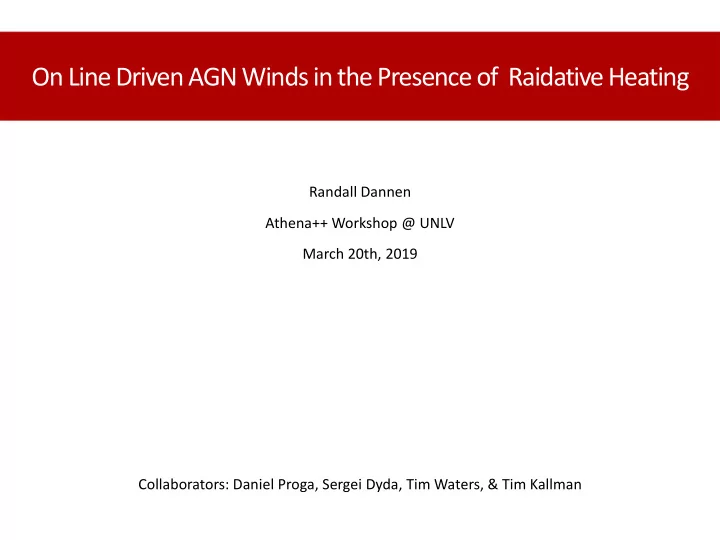

On Line Driven AGN Winds in the Presence of RaidativeHeating Randall Dannen Athena++ Workshop @ UNLV March 20th, 2019 Collaborators: Daniel Proga, Sergei Dyda, Tim Waters, & Tim Kallman
Motivation Arav et al. 2015
Spectral Energy Distribution Mehdipour et al. 2015
Spectral Energy Distribution Mehdipour et al. 2015 Ionizing radiation (13.6eV – 13.6 keV)
Introduction
Introduction The radiative heating and cooling rates due to the incident SEDdetermined by the photoionization code XSTAR (Bautista & Kallman 2001), dependent on the ionization parameter, ξ , and gas temperature. XSTAR is a command- driven computer program for calculating the physical conditions and emission spectra of photoionized gases (Bautista & Kallman 2001).
Heating and Cooling
Heating and Cooling Compton bremsstrahlung lines and recombination photoionization
Heating and Cooling
Heating and Cooling Dyda et al. 2017 Assuming spherically symmetric distribution for the gas irradiated by a uniform radiation field.
Heating and Cooling Dyda et al. 2017 Assuming spherically symmetric distribution for the gas irradiated by a uniform radiation field.
Radiation Force
Radiation Force
Radiation Force electron scattering
Radiation Force The force multiplier due to line absorption. electron scattering
CAK Castor, Abbott, & Klein (1975; CAK hereafter) give us an expression for the radiation force due to lines, We now introduce scaling factor using the Sobolev approximation
Sobolev Approximation To simplify our calculations, we introduce the Sobolev approximation, one of the most effective means if modeling spectra of astrophysical objects (V .P.Grinin, 2001). The approximation is as follows: for an astrophysical object with large velocity gradients, the interaction between the matter and radiation can characterized by it's local properties.
CAK Modified CAK So maybe we can use the ionization parameter length scale instead?
CAK Now let’s write an expression for the total force due to lines Where M(t) is our force multiplier (Abbot 1982),
Line List
Ionic Abundances
Level Populations Combining our newly constructed atomic dataset and our ion abundances determined from XSTAR , we take this data and apply them to the previously shown equations with the final assumption being that the level occupancy follows the Botlzmann excitation equation.
Force Multiplier Results
Force Multiplier Results
Force Multiplier Results
Hydro Setup Much like for the thermally driven winds, we choose a spherically symmetric setup, but instead of a uniform radiation field, we instead assume the radiation is provided by a central point source.
Hydro Setup Much like for the thermally driven winds, we choose a spherically symmetric setup, but instead of a uniform radiation field, we instead assume the radiation is provided by a central point source. We need to specify three quantities at the inner boundary. First, we specify the ionization parameter at the inner radius of our domain
Hydro Setup Much like for the thermally driven winds, we choose a spherically symmetric setup, but instead of a uniform radiation field, we instead assume the radiation is provided by a central point source. We need to specify three quantities at the inner boundary. First, we specify the ionization parameter at the inner radius of our domain We specify the flux relative to the Eddington flux
Hydro Setup Much like for the thermally driven winds, we choose a spherically symmetric setup, but instead of a uniform radiation field, we instead assume the radiation is provided by a central point source. We need to specify three quantities at the inner boundary. First, we specify the ionization parameter at the inner radius of our domain We specify the flux relative to the Eddington flux We define HEP as the ratio of the gravitational and thermal energy. For HEP < 10, we should find a thermally driven wind.
Prelimanary Results
Prelimanary Results We find that although the force multiplier can be • large, even for highly ionized gas, we see that through the coupling of the our parameters (photoionization parameter, Flux, and HEP) we cannot produce a radiative driven wind, the force of gravity will always be much larger than the radiation. Thermal driving will dominate the line driving, even • when the gas is nearly isothermal.
Recommend
More recommend